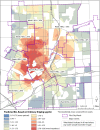Elevated Blood Lead Levels in Children Associated With the Flint Drinking Water Crisis: A Spatial Analysis of Risk and Public Health Response
- PMID: 26691115
- PMCID: PMC4985856
- DOI: 10.2105/AJPH.2015.303003
Elevated Blood Lead Levels in Children Associated With the Flint Drinking Water Crisis: A Spatial Analysis of Risk and Public Health Response
Abstract
Objectives: We analyzed differences in pediatric elevated blood lead level incidence before and after Flint, Michigan, introduced a more corrosive water source into an aging water system without adequate corrosion control.
Methods: We reviewed blood lead levels for children younger than 5 years before (2013) and after (2015) water source change in Greater Flint, Michigan. We assessed the percentage of elevated blood lead levels in both time periods, and identified geographical locations through spatial analysis.
Results: Incidence of elevated blood lead levels increased from 2.4% to 4.9% (P < .05) after water source change, and neighborhoods with the highest water lead levels experienced a 6.6% increase. No significant change was seen outside the city. Geospatial analysis identified disadvantaged neighborhoods as having the greatest elevated blood lead level increases and informed response prioritization during the now-declared public health emergency.
Conclusions: The percentage of children with elevated blood lead levels increased after water source change, particularly in socioeconomically disadvantaged neighborhoods. Water is a growing source of childhood lead exposure because of aging infrastructure.
Figures


Comment in
-
Hanna-Attisha and LaChance Respond.Am J Public Health. 2016 Jun;106(6):e1-2. doi: 10.2105/AJPH.2016.303184. Am J Public Health. 2016. PMID: 27153023 Free PMC article. No abstract available.
-
Lessons for Flint's Officials and Parents From Our 1970s Newark Lead Program.Am J Public Health. 2016 Jun;106(6):e1. doi: 10.2105/AJPH.2016.303149. Am J Public Health. 2016. PMID: 27153024 Free PMC article. No abstract available.
-
Flint Blood Lead Levels: Four Questions.Am J Public Health. 2016 Dec;106(12):e6. doi: 10.2105/AJPH.2016.303486. Am J Public Health. 2016. PMID: 27831788 Free PMC article. No abstract available.
-
Hanna-Attisha and LaChance Respond.Am J Public Health. 2016 Dec;106(12):e6-e7. doi: 10.2105/AJPH.2016.303487. Am J Public Health. 2016. PMID: 27831790 Free PMC article. No abstract available.
References
-
- Associated Press. “I don’t even let my dogs drink this water.” CBS News. March 4, 2015. Available at: http://www.cbsnews.com/news/flint-michigan-break-away-detroit-water-rile.... Accessed October 3, 2015.
-
- City of Flint 2014 Annual Water Quality Report. 2014. Available at: https://www.cityofflint.com/wp-content/uploads/CCR-2014.pdf. Accessed September 30, 2015.
-
- Edwards M, Triantafyllidou S. Chloride to sulfate mass ratio and lead leaching to water. J Am Water Works Assoc. 2007;99(7):96–109.
-
- Edwards M, McNeill LS. Effect of phosphate inhibitors on lead release from pipes. J Am Water Works Assoc. 2007;94(1):79–90.
-
- Edwards M, Falkinham J, Pruden A. Synergistic impacts of corrosive water and interrupted corrosion control on chemical/microbiological water quality: Flint, MI. National Science Foundation Grant abstract. Available at: http://www.nsf.gov/awardsearch/showAward?AWD_ID=1556258&HistoricalAwards.... Accessed September 10, 2005.
MeSH terms
Substances
LinkOut - more resources
Full Text Sources
Other Literature Sources
Medical

